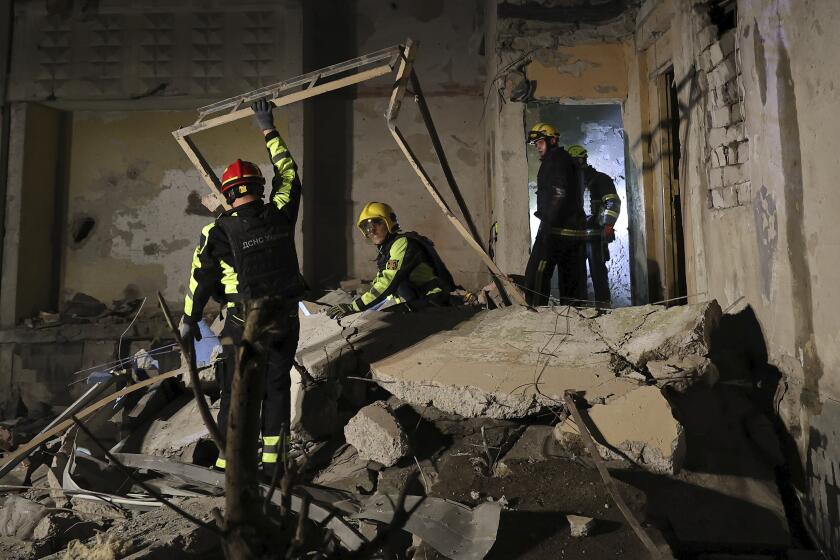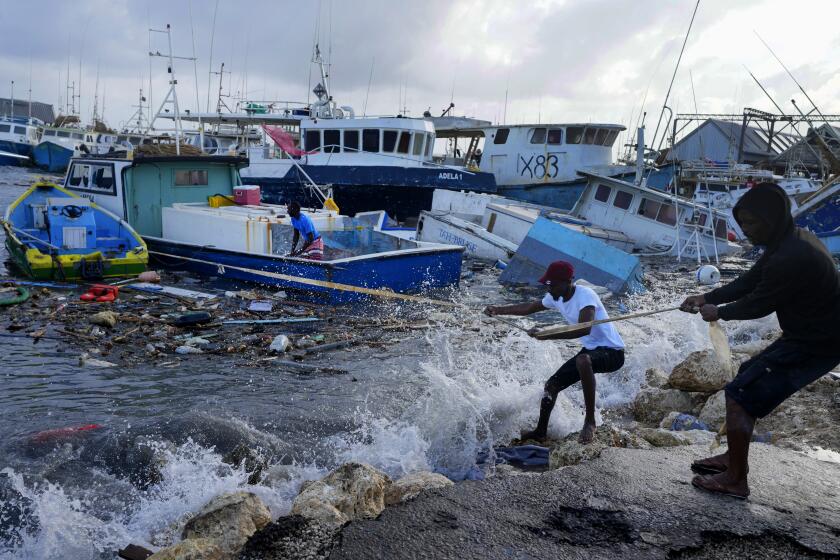Pi in the sky: Math could help protect against terrorism
THERE may be a new weapon for helping guard the nation’s airplanes against terrorism -- and this one doesn’t come loaded with bullets or employ Space Age technology. It is mathematics. Or specifically, the mathematics involved in the field of operations research.
Operations research is a little-known but valuable tool for such things as scheduling airline flight crews, planning National Football League seasons and even designing waiting lines at Walt Disney World. And in a report released on Monday, it was used to assess the effectiveness of the nation’s security screening of airline passengers.
Using a mathematical model, Susan E. Martonosi, an assistant professor of mathematics at Harvey Mudd College in Claremont, and Arnold Barnett, a professor of management science at MIT, sought to explore the effectiveness of the “no-fly” lists in preventing terrorism. The conclusions they reached were less remarkable perhaps than the way they evaluated the program.
They found that improving the screening required of all passengers at security checkpoints would do more to enhance security than further refinements to the pre-screening of passengers by no-fly lists.
The Transportation Security Administration has run afoul of privacy groups and Congress in its attempts to update the no-fly list, which before Sept. 11 was called CAPPS for computer assisted passenger profiling system. The old system flagged six of the 19 hijackers on Sept. 11, for secondary screening, but that additional checking did not prevent them from boarding their flights. After an attempt at a CAPPS II was scrapped in 2004, the TSA is moving forward with a newly named passenger profiling system it calls Secure Flight.
“We are getting very close to completion,” said TSA spokeswoman Jennifer Peppin-Marty. “Privacy and security are being built into the foundation of the program.”
Currently, the airlines are charged with making sure that passengers are not on the watch list. It is compiled based on recommendations and information received from federal agencies, including law enforcement and intelligence. When Secure Flight is implemented, that responsibility will transfer to the TSA.
The effectiveness of Secure Flight in deterring or preventing terrorism is an open question and the one that Martonosi and Barnett sought to answer.
Critics of Secure Flight note that it would be simple for terrorists to probe the system, sending their members on flights just to see who would be selected for secondary screening. Those who were not selected by the government would become the lead candidates for any planned terrorist act.
“Whenever you divide people into two categories -- more suspicious and less suspicious -- you invite the bad guys to figure out how to get into the ‘search-me-less line,’ ” said Bruce Schneier, security expert and author of “Beyond Fear, Thinking Sensibly About Security in an Uncertain World.”
Then there is the problem that there is no clear picture of what a terrorist looks like.
“There’s this myth ... that somehow there is a profile of the bad guys, and it’s not true,” Schneier said. Richard Reid, who attempted to blow up an airplane using a bomb hidden in his shoes, is a British citizen born in London and the son of an English mother and a Jamaican father.
“There’s an enormous danger and enormous insecurity in relying on a profile,” Schneier said. “Pre-identification doesn’t really help much, so why are we bothering?”
Others, however, including former Secretary of Transportation Norman Y. Mineta, believe that a strong pre-screening program is the “foundation” of aviation security.
“The government can assure travelers that known terrorists are not getting on airplanes today, because every flight manifest is vetted against the watch list,” said the TSA’s Peppin-Marty.
Martonosi and Barnett’s mathematical analysis of the two viewpoints brings them down on the side of the critics of Secure Flight, though not resoundingly.
“A little improvement in baseline security would be better than a little improvement in the security measures applied to high-risk passengers,” Barnett said.
Such improvements could include deploying technology for better detection of plastic or liquid explosives carried by passengers. They believe there could be a deterrent effect that would magnify the benefits of the changes, keeping terrorists from even bothering with the airport in the first place.
“This is just looking at the probability of being able to thwart an attack, not considering the cost of such measures,” Martonosi said.
Schneier is blunter in his assessment of how we could enhance airline security, saying we should return checkpoints to their pre-Sept. 11 status, when we didn’t have to remove shoes or surrender our toothpaste. “All you’re stopping now are the sloppy and the stupid,” he said. “What we’re doing is defending against what the terrorists did last time.”
He would use the freed-up resources to hire and train plainclothes agents who would look for suspicious activity. “That is going to catch things in ways that checkpoints won’t,” he said.
The TSA had not seen the report and could not comment on its specifics, but it did issue a general statement about its approach to security.
“There is no silver bullet for security,” Peppin-Marty said. “TSA employs multiple layers of security that span from the curb at the airport to the cockpit of the aircraft -- examples include K-9s, federal air marshals, hardened cockpit doors, new technology at our checkpoints etc.”
Martonosi and Barnett said that individuals within the TSA are using mathematics to evaluate these layers of security. “There are certainly people who work with these models,” Barnett said. “The question is, how often do these models work their way into policy?”
They argue that approaching the problem this way is as important as what their study revealed. “No one knows for sure what the answers are for security,” Barnett said. “But let’s at least make sure we’re thinking about it in a systematic way.”
*
More to Read
Sign up for Essential California
The most important California stories and recommendations in your inbox every morning.
You may occasionally receive promotional content from the Los Angeles Times.










